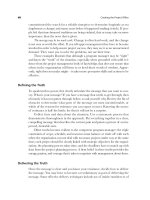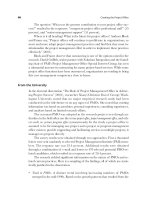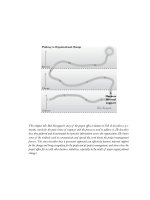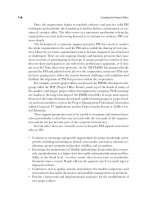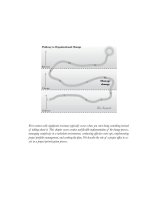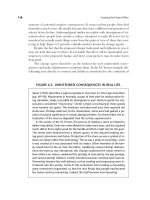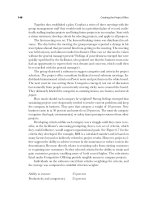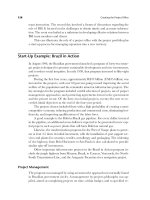Tài liệu Creating the project office 22 ppt
Bạn đang xem bản rút gọn của tài liệu. Xem và tải ngay bản đầy đủ của tài liệu tại đây (188.46 KB, 10 trang )
management support, PM library, project management forums, and PM funda-
mentals training.
Then they measured participation on a monthly basis, and worked to improve
the level of service through analysis of this data. They also ran an end-user sur-
vey on a quarterly basis. One thing this report revealed was the high volume of
demand for documentation and proposal generation, support, and PM method-
ology support. No demands for PM mentoring and coaching were realized.
Status of the Local PMO.
Bucero proceeded in a step-by-step process to staff the
PMO. He started with two people, then added two more at one-month intervals
until he reached six people. He could increase the number of people because their
actions demonstrated added value to the organization. They all focused on the
DMS (managing and elaborating proposals, presentations, methodology forms,
and templates). As soon as project managers felt supported and relieved of those
tasks, they indirectly began selling PMO services to the whole organization. Face-
to-face feedback also provided a valuable mechanism to sell high-performing
PMO services.
Currently there are ten people on the team (five DMS specialists, two tool
specialists, one Quality specialist, and two trainees). The focus going forward is to
get more project managers involved in PMO activities and able to mentor and
coach junior PMs. One key success factor has been to create a knowledge-shar-
ing culture inside and outside the PMO. Project retrospective analysis is an on-
going and helpful activity for sharing case studies among project managers and
team members.
The forecast is to have two full-time project managers working with the pro-
gram manager in the PMO delivering project management consulting services
inside and outside the organization.
The PMO Evolution
Project management offices were started in different sites and countries but with-
out common objectives. However, the HP Consulting organization as a whole un-
derstood the tendency in the project business was to be more and more global.
Reinventing the wheel every time in each country was not effective. They were
creating project offices in each country but not able to share things because of dif-
ferent approaches. They needed to define a common approach to move forward.
They had a lot of professional project managers with a lot of experience, a
Project Management Initiative, a Quality Initiative, a Knowledge Management
188 Creating the Project Office
Initiative, and the need to share real cases and experiences was a reality. How to
manage that puzzle? How to fix all the parts?
From their Project Management Initiative (PMI) meetings, people were es-
calating local problems with PMO implementation. Then a task force was cre-
ated and managed by one of the upper managers. This professional organized
the first meeting in California, asking PMI leaders to participate. Ideas were col-
lected before the meeting from PMOs around the world so basic ideas could be
shared. PMO leaders from different countries participated, sharing their opinions
and validating both the idea and potential structure for the Program Manage-
ment Office.
During the meeting they discussed the content, services, roles, responsibili-
ties, and priorities for a proposed Global Program Management Office. At the
end of the meeting they had an action plan for moving forward. After this meet-
ing, the manager heading the initiative delivered the proposal in a presentation to
the upper-level management team at the corporate office. The team also orga-
nized monthly teleconferences to keep in touch.
Status was shared among the team by e-mail. Some weeks after the first meet-
ing the idea of a Global Program Management Office was accepted by upper
management and other organizations joined in. Two months later, the organiza-
tion changed. The leader retired. Then the initiative was stopped for some time.
Since the HP and Compaq merger, the new Consulting and Integration Services
is being redesigned around the PM Compaq methodology. As of late 2002, the
PMO leaders are expecting movement about the Global Program Management
Office implementation.
So far the focus has been on practical experience to implement a local PMO,
but additional efforts are in place to manage different project office implementa-
tions for each location depending on the needs and project requirements, the
project culture maturity level, the resources and type of projects, and the business.
When an organization wants to become project-oriented, a common model is
needed.
The team of PMO leaders identified the factors listed in Figure 7.8 as essen-
tial to support the project office evolution. Bucero adds,
The team documented the following unifying assumptions: To implement this
model a Program Management Office structure needs to be created and im-
plemented at multiple levels. To successfully implement this mode we need top
management sponsorship and all stakeholders must be involved. That requires
a cultural change and measures and metrics that need to be changed in our
organization.
Implementing the Project Office 189
We will focus on our customers, covering all phases during the project life
cycle according to the PMBOK. We will demonstrate to our customers that
all parts of the organization support the project manager along the complete
project life cycle to achieve customer requirements.
We will implement a quality assurance process along our whole organi-
zation, convince people of the added value of this process, and be aligned with
customer needs, values, and culture.
We will have a common approach from all organizations inside our com-
pany. Each department, organization, or division should work together with
common objectives and think about customer satisfaction. There should not
be different projects for the same customer inside our organization. This com-
mon approach must be agreed upon as the strategic plan for the company as
a whole.
The quality assurance process they developed is outlined in Figure 7.9.
Bucero goes on to note,
The Program Management Office consolidates all project support activities
that have resided in the different company organizations or departments. It
supports the local implementation of a common model based on processes,
skills, and project management development, coaching, and mentoring, pro-
viding a structured monthly project status report.
The proposed model should have a Global Program Management Office
established that defines all processes, practices, and tools associated with the
common model. This organism must manage and support complex and global
190 Creating the Project Office
FIGURE 7.8. KEY SUCCESS FACTORS.
Project
Office
Success
Common processes,
metrics, and methods
Project estimating, budgeting,
and reporting
Tools and systems
Project management
skills
Structure and visibility
projects, lead the project management learning communities, and produce
periodic project status reports. On the other hand, the local Program Man-
agement Offices must support local implementation of the common model
established, manage the local project portfolio, lead project managers, be re-
sponsible for local project management, and sponsor development programs.
The charter of the Program Management Office is to ensure that the
processes, practices, capabilities, tools, and systems are in place to effectively
support the project business and thus establish the foundation for improving
the maturity level of the organization.
Geographic PMO Responsibilities
The main responsibility for the geographic PMOs is managing the project port-
folio. This entity is responsible for reviewing portfolio reports and providing business
management with recommendations. It also ensures follow-up and implementa-
tion of decisions made by upper management. The geographic PMO is measured
and accountable for planned versus actual gross margin for the project portfolio.
Implementing the Project Office 191
FIGURE 7.9. A COMMON QUALITY ASSURANCE PROCESS.
Quality
Assurance
Reviews
Performed locally
• Customized locally
• Following global rules
• Being shared globally
• Sales
• Support
• Legal
• Administration
• Marketing
• Decision to invest
• PM and sponsor assignment
• Decision making
• Project risk versus opportunities
Depending on project
size and complexity
Results
All the company organizations
working together
Standard process defined
It is responsible for driving knowledge creation and reuse according to defined
processes. It ensures that project managers are well skilled by leading PM train-
ing, coaching, mentoring, and professional certification. The geographic PMO
conducts sponsorship training and mentoring for business managers and deploys
the necessary processes, practices, capabilities, tools, and systems.
Resource planning is another key responsibility tied to business planning, po-
tential deals, and the existing portfolio. The geographic PMO plays the role of
project sponsor for projects as necessary and provides bid management support
to geographical area projects—collecting client references, generating proposals,
managing the bid, and providing quick quote service, project planning, and pro-
posal review facilitation.
The geographic PMO provides these services:
• Snapshot and retrospective analysis facilitation
• Customer surveys
• Quality audits
• Methodology support
• Schedule management
• Cost management (overall tracking and control)
• Time management (WBS development and support)
• Risk management (overall tracking and control)
• Communication management
• Procurement management
• Document management support
• Technical writing support
Global PMO Responsibilities
The Global Project Management Office leads the PMO Council formed by global
and geographic PMO leaders to determine the processes, practices, capabilities, tools,
and systems that will be implemented by the geographic PMOs. The Global PMO
reviews company project portfolio reports at the global level, provides business man-
agement with recommendations and drives follow-up on those recommendations,
and conducts global analysis on trends to determine good practices and training and
process improvements. One key responsibility is to support international opportuni-
ties and projects during selling and delivery phases, conducting project reviews and
recommendations, supporting resources and staffing, assessing the risk, escalating
problems when needed, conducting local team start-up and on-the-job training, and
conducting sponsorship training and mentoring for business managers.
192 Creating the Project Office
